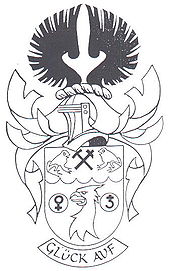Good luck for

Glückauf (alternative spelling Glück Auf ; as exclamation "Glück auf!" ) Is the German miner's greeting . He describes the hope of the miners , "it may be veins open up" (curtailment of the longer salutation "I wish you luck, do a new gear on"), for the mining of ores could be without prospecting only unsafe to predict whether the work of the Would lead miners to any wage at all. Furthermore, this greeting is linked to the wish for a healthy exit from the mine after the shift .
Emergence
The greeting originated in the Saxon Ore Mountains towards the end of the 16th century, when the miners still drove in and out on foot via journeys (ladders) or with the art of driving . (In a mine You always drives one and not into it , whether you are on foot, with the hoisting cage or with the mine train enters.) This meant that the miner is a 10-hour shift often an arduous and dangerous two-hour -Had climbing part of the trip ahead of him, something that needed luck. If a miner lost his drive , he fell into the shaft. In addition, fatal accidents were very common at that time (16th to 18th centuries), not just when driving in and out. It often happened that mates on the next shift, who had been greeted as they drove out, stayed in the mountain.
Historical use

|

|
|
|
1 Pfennig, Kingdom of Hanover , Ernst August , minted in 1839 on the occasion of the king's visit to a coin ( Welter 1812)
|
||
The miner's greeting was already mentioned before 1700 in the old miner's song Glück Auf, der Steiger comes artistically and has thus become part of the folk song .
Mines like Zeche Glückauf-Tiefbau , Zeche Glückauf Barmen or Zeche Glückaufsegen were named like this.
The greeting has been widely used by speleologists ( speleologists ) since at least 1890 and is still the most common form of greeting today. It is particularly common when running in.
Usage today


The miner's greeting can still be found in mining today . It is used, for example, on festive mining occasions and among miners . The "Glückauf" is used in the mining industry in official and private correspondence as a greeting ( with friendly Glückauf! ).
Since the ores were smelted close to the pits, this greeting has also become common among the smelters in some locations (Harz, Freiberg). The often invoked cohesion of smelters and miners (“coal and steel”) has also contributed to this, even if this tradition is increasingly being forgotten by steel workers today.
In traditional mining regions, it is also used by non-miners. In the Ore Mountains, Upper Harz and Ruhr Area, the greeting is still used today in everyday life ( Ore Mountains : "Glick Auf!", "Gliggauf") - preferably among men. It is also used in modifications (e.g. “Gauf!”, “Auupp!”) In the regional youth language. At the Montanuniversität Leoben , too, greetings are given with “Glück Auf!” On official occasions as well as at the start of classes, but the greeting is also of elementary importance in the life of the student associations in Leoben. In the rest of Styria , the greeting is also widespread due to the historical mining tradition, but is closer to the original meaning as a congratulatory formula (in the form "a Styrian happiness!").
At home games of FC Schalke 04 and FC Erzgebirge Aue , the audience is welcomed with "Glück auf", while the Steigerlied is played at the same time. The former venue of the Gelsenkircheners was the Glückauf-Kampfbahn (until 1973).
The "Glückauf" is also the greeting from the technical relief organization .
The "Glückauf" is often used in speeches or speeches in the DGB trade unions .
Related terms
- " Glück zu !" Is the traditional greeting of the millers .
- "Glück ab!" Is the battle cry in the Bundeswehr in parachute jumping
literature
- G. Heilfurth: Glückauf! History, meaning and social strength of the miner's greeting . Glückauf, 1958.
Web links
Individual evidence
- ^ Wilhelm Hermann, Gertrude Hermann: The old collieries on the Ruhr (series: The Blue Books ). Verlag Langewiesche Nachhaben, Königstein im Taunus, 6th, expanded and updated edition. 2008, ISBN 978-3-7845-6994-9 , p. 323.
- ↑ Luck or Coincidence. In: Jacob Grimm , Wilhelm Grimm (Hrsg.): German dictionary . tape 8 : Glibber – Gräzist - (IV, 1st section, part 5). S. Hirzel, Leipzig 1958, Sp. 220-276 ( woerterbuchnetz.de ). - (here Col. 259: “ since the second half of the 17th century, initially in Saxon as miner's grusz, interpreted as the opening up of the ore veins: luck open !”).
- ^ Heinrich Veith: German mountain dictionary with evidence . Wilhelm Gottlieb Korn, Breslau 1871, p. 170 .
- ^ Emil Carthaus: Bilstein caves near Warstein. 1890.
- ↑ See e.g. B. “Warm 'Glück auf' for the future” - DGB regional chairman Helmut Fiedler said goodbye ( memento of the original from December 18, 2014 in the Internet Archive ) Info: The archive link was inserted automatically and not yet checked. Please check the original and archive link according to the instructions and then remove this notice. or website of the DGB region Schweinfurt-Würzburg ( page no longer available , search in web archives ) Info: The link was automatically marked as defective. Please check the link according to the instructions and then remove this notice. or Mairede by Reiner Hoffmann on May 1, 2013 , all accessed on March 20, 2014.
- ↑ "Glück zu" was the miller's greeting. Retrieved September 4, 2010 .
